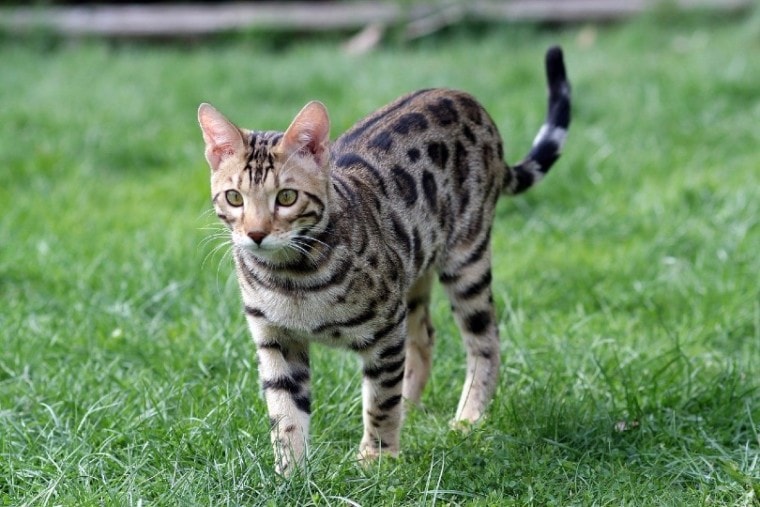
If one breed of cat tends to stand out among the rest, it’s the Bengal cat. They have an iconic “jungle” cat appearance, sleek, spotted coats, long hind legs, and tall ears with round tips. Many Bengal cat fans love that they look like miniature leopards, although their coat and markings can vary significantly. As a cross between an Asian Leopard Cat and a domestic shorthair cat, the Bengal was first bred in the early 1900s. It wasn’t until the late 1960s or early 1970s, however, that the Bengal breed was firmly established.
If you’ve recently adopted a cat and you’re wondering if it’s possibly a Bengal mix, here are 10 ways to help you make the determination.
The 10 Tips on How to Tell If Your Cat Is a Bengal Mix:
1. Look Closely at Your Cat’s Coat
If there’s one thing that sets the Bengal apart, it’s their lovely, leopard-like coat. Not only will it be spotted (thanks to its Asian Leopard Cat heritage), but if your cat is a Bengal mix, its coat will also be incredibly dense. Moreover, your cat’s coat will likely be hypoallergenic and ticked if they have a bit of Bengal in them. Speaking of coats, four types are typical for the Bengal breed. If yours is a Bengal mix, they will likely have one of the following coats:
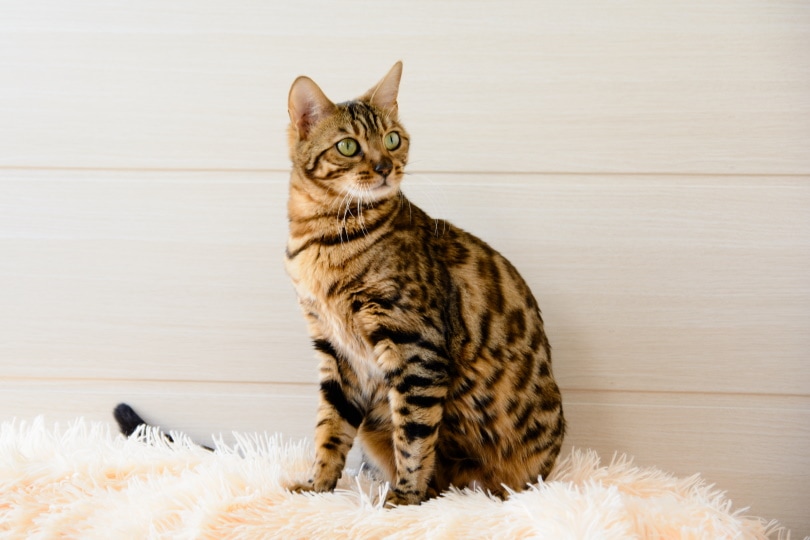
2. Look at Your Cat’s Body Structure and Size
One of the best ways to tell if your cat is a Bengal mix is to closely examine its overall body structure and size. Bengal cats are known for having long, lean, and muscular bodies. It’s rare for a Bengal cat, or a Bengal mix, to get chubby as their metabolism is faster, and they move differently than regular domestic cats.
More notably, a Bengal has hind legs that are higher than their front legs, giving them a stride that’s much different from your typical house cat. Bengals also have longer bodies and smaller heads, with eyes that are more round than oval and rounded tips on the tops of their ears. If your cat has several, or all, of these distinct features, there’s a high likelihood that it’s a Bengal mix.
3. Is Your Cat Extremely Agile and an Unusually Strong Jumper?
As we discussed earlier, Bengal cats have long, lithe, muscular bodies that are substantially stronger than the average house cat. For that reason, they can jump higher and love getting as high up as they can wherever they happen to live.
Yes, most house cats are amazing climbers, but a Bengal cat puts their skills to shame. If you’ve found your cat in places where you’ve said, “How in the world did he or she get up there?” chances are your cat is a Bengal mix.
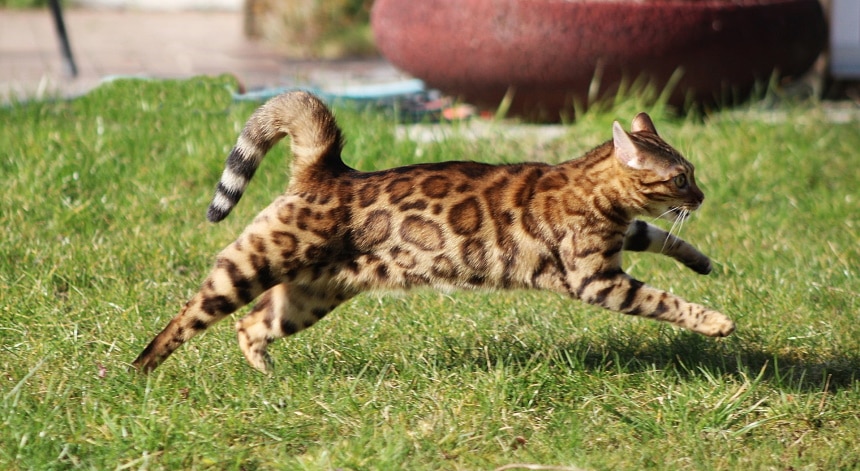
4. Does Your Cat Love Being in and Around Water?
If you’ve had or been around cats, you know they’re not big fans of H2O and will generally avoid getting wet at all costs. On the other hand, the Bengal cat loves being in the water, is a strong swimmer, and will seek out water in your home to play with. If they hear water running, a Bengal cat will come to investigate and have some fun. If your cat does these things and occasionally goes to the bathroom in water also, there’s a good chance they have some Bengal cat blood in them.
5. Does Your Cat Have an “M” on Their Forehead?
One of the distinct markings Bengal cats have is short stripes in the shape of an “m” on their forehead. They also have what looks like a thumbprint on their ears, a spot where the fur is shorter and looks like someone pressed their thumb into it. One thing to keep in mind, though, is that tabby cats can have these same markings.
If these are the only traits your cat has in common with a Bengal, they might be a tabby instead. However, if they have these traits and several others, the chance they’re a Bengal mix is much higher.
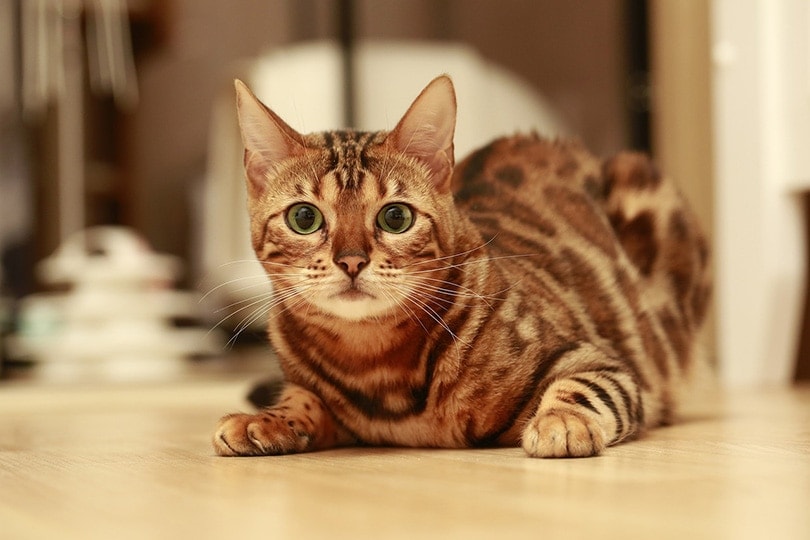
6. Is Your Cat Is Very Vocal and Talkative?
Some house cats like to talk, and of course, most of them purr, meow, and make other sounds. Bengal cats make all these sounds but with much more enthusiasm and a wider range of them, including deep grunts, high-pitched yowls, and even screams.
Kittens also tend to chirp in a way that’s more like a bird than a cat, which is delightfully weird to hear from a cat! If your cat is highly vocal and makes many sounds utterly different from most cats you’ve had, the possibility is high that they’re a Bengal mix.
7. Does Your Cat Seem To Have Boundless Energy?
One trait that differentiates Bengals from house cats is their amazingly high energy levels. Bengals always seem to be moving and searching for something to do. For this reason, Bengal cats have a hard time being confined to small areas and don’t make the best pet if you live in a tiny home or apartment.
If they’re in a small living space, Bengals will look for ways to escape and have been known to open doors and windows! If your cat is a bundle of non-stop energy, loves to play with you, and is always getting into trouble, they might be part Bengal.

8. Is Your Cat Extremely Intelligent?
One of the earmarks of the Bengal cat is its high level of intelligence. As we mentioned above, Bengals have been known to learn how to open doors and windows on their own. Unlike most house cats that would never be OK with you taking them for a walk on a leash, Bengal cats are often just fine with it.
You can put on a harness and a leash and walk them just like you would a dog (but with infinitely more swagger). If you’ve been able to teach your cat complex tricks like using the toilet or playing ice hockey, there’s a distinct possibility they’re a Bengal mix.
9. Check To See if Your Cat’s Coat Is Asymmetrical
Most house and tabby cats are symmetrical, meaning that the fur pattern on one side of their body is identical (or at least close) on the other side of their body. Bengal cats, however, are asymmetrical, and the patterns on the left and right sides of their body are completely different. If your cat has different markings on each side of its body, the chance they’re a Bengal mix is quite high.
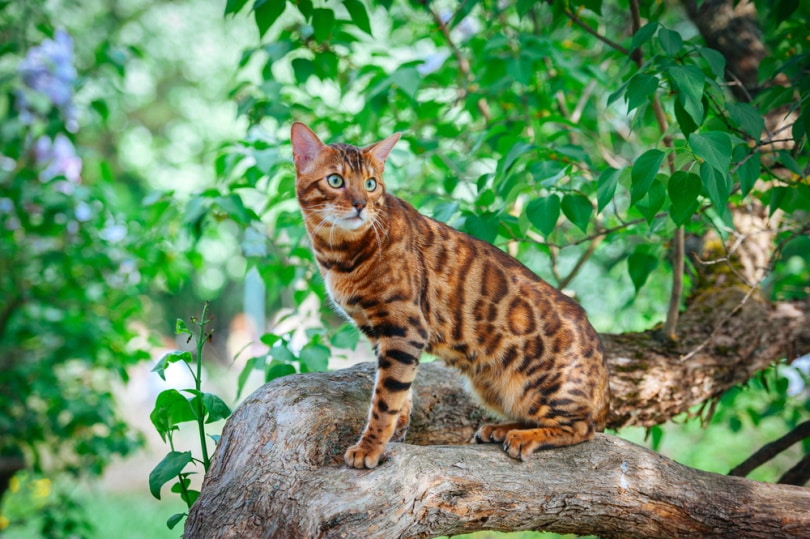
10. Ask Your Vet To Perform a DNA Test
While this isn’t a way for you to tell if your cat is a Bengal mix, it is the best way to know if they are or not. Simply ask your vet to perform a DNA test on your pussycat. Bengal cats have specific DNA markers that will show up in a DNA test, and if they do, you’ll know for certain that they are (or aren’t) a Bengal mix.
The tests don’t cost much, are harmless to your cat, and will give you an affirmative “yes” or “no” answer to whether they have Bengal blood in their genes.
Final Thoughts
Now that you’ve seen how to tell if your cat is a Bengal mix, what do you think? Is there a possibility your frisky feline shares some genes with a Bengal cat, or are you now sure that they’re not? Using the 10 ways above (especially #10, the DNA test), you should be able to determine if your cat is part Bengal or just an ordinary (but still lovable) house cat. Whether your cat is a Bengal mix or not, we hope you still find them fun, adorable, and affectionate.
Featured Image Credit: Irina_kukuts, Pixabay






